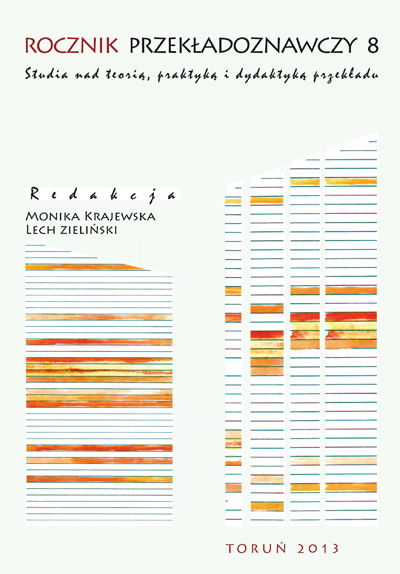Między uniwersytetem a rynkiem. Tłumacz języka hiszpańskiego w Polsce w świetle wyników badań ankietowych
DOI:
https://doi.org/10.12775/RP.2013.001Słowa kluczowe
tłumacze w Polsce, tłumacze języka hiszpańskiego, wykształcenie a rynekAbstrakt
Referat omawia wstępne wyniki pierwszego badania przeprowadzonego w grupie zawodowej tłumaczy języka hiszpańskiego. Przy pomocy kwestionariusza opartego na introspekcji uzyskano dane na temat różnych aspektów działalności zawodowej tłumaczy: wykształcenia, aktualnej kompetencji tłumaczeniowej, a także metod pracy, czynników afektywnych, prestiżu, poczucia własnej skuteczności oraz sukcesu zawodowego. Jednym z centralnych zagadnień badania była konfrontacja wykształcenia tłumaczy z realiami rynku pracy.Bibliografia
Bandura, A., 1977, „Self-efficacy: Toward a unifying theory of behavioral change”, Psychological Review, 84, s. 191–215.
Centrum Badania Opinii Społecznej, (2009), Prestiż zawodów, http://www.cbos.pl/SPISKOM.POL/1999/K_032_99.PDF (dostęp: 20 maja 2010 r.).
Duffy, T.M., 1997, „Strategic Teaching Frameworks: An Instructional Model for Complex, Interactive Skills”, [w:] Instructional Development State of the Art., Vol. 3, C. Dills i A. Romiszowski (red.), Paradigms. Englewood Cliffs, NJ: Educational Technology Publications, s. 571–592.
Echeverri, Á., 2009, Métacognition, apprentissage actif et traduction: l’apprenant de traduction, agent de sa propre formation, nieopublikowana praca doktorska, Universite de Montreal, Canada.
Hansen, G., 2006, „Retrospection methods in translator training and translation research”, JoSTrans 5, www.jostrans.org/issue05/art_hansen.pdf (dostęp: 20 maja 2010 r.).
Hurtado Albir, A. i Orozco, M., 2002, „Measuring translation competence acquisition”, Meta, Vol. 47, No 3, s. 375–402.
Livingston, J.A., 1997, Metacognition: An overview, http://www.gse.buffalo.edu/fas/shuell/cep564/Metacog.htm#Top (dostęp: 20 maja 2010 r.).
Muñoz Martín, R., 2006, „Pericia y entorno de la traducción”, [w:] Corcillum. Estudios de traducción, lingüística y filología dedicados a Valentín.
García Yebra, C. Gonzalo García i P. Hernúñez (red.), Madryt, Arco libros, s. 131–146, http://www.petraweb.org/Munoz%20Pericia%20y%20entorno%20de%20la%20traduccion.pdf (dostęp: 20 maja 2010 r.).
PACTE, 2002, „Una investigación empírico-experimental sobre la adquisición de la competencia traductora”, [w:] La traducción científico-técnicay la terminología en la sociedad de la información, Castellón de la Plana, Publicaciones de la Universitat Jaume I, A. Alcina Caudet i S. Gamero Pérez (red.), s. 125–138.
PACTE, 2008, „First results of a Translation Competence Experiment: »Knowledge of Translation« and »Efficacy of the Translation Process«”, [w:] Translator and Interpreter Training. Issues, Methods and Debates, John Kearns and Contributors, 2008, s. 104–126.
Velmans, M., 1999, „Intersubjective Science”, Journal of Consciousness Studies, 6, No. 2/3, s. 299–306, numer specjalny w serii First-person approaches, F.J. Verela, J. Shear.
Velmans, M., 2000, Investigating Phenomenal Consciousness. New methodologies and maps, John Benjamins.
Vrasidas, C., 2000, „Constructivism versus objectivism: Implications for interaction, course design, and evaluation in distance education”, International Journal of Educational Telecommunications, 6(4), s. 339–362.
Pobrania
Opublikowane
Numer
Dział
Statystyki
Liczba wyświetleń i pobrań: 452
Liczba cytowań: 0



